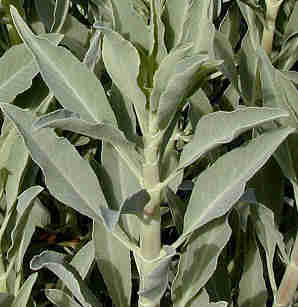
White Sage Salvia Apiana
Family: LamiaceaeWhite sage can be found throughout Mediterranean areas where development has not encroached on its habitat. In southern California, it grows in stands in plant communities of coastal sage scrub, and is often the dominant species. It is one of the most aromatic of the Salvias; the scent coming from the fuzzy, thick, silvery-green leaves rather than the flowers.
Leaves are 1" to 4" long, opposite with short petioles that wrap around the 4-sided stems to join the leave on the opposite side. Leaves form thick rosettes at the ends of the stems, though leaves along the stem are fairly sparse. The 4-sided stems are typical of all members of the mint family.
S. apiana's stems are sticky and as thick as leaves and petioles. Flowers appear in spring, are white with a tinge of lavender, two-lipped with bottom petals protruding far beyond very small upper lips, and are borne in loose clusters on very long wand-like stalks. Mature shrubs reach 2- to six feet in height. In some areas, especially in California, the shrubs cover the entire hillsides. White sage is found with other sages and cross-pollinates to form many hybrid varieties.
White sage has a wide range of medicinal properties. Like all odoriferous sages, the leaves are powerful antiseptics, used for abrasions and a spectrum of skin inflammations, douches to treat Candida and staph infections, and sore throats, colds, and lung infections.
Drunk hot, an infusion of the leaves stimulates perspiration, thus lowering fevers. Inhaling the steamed leaves broke up chest congestion. Drunk cold, all bodily secretions are inhibited, which gives rise to the herb's use in weaning babies from the breast. The mother would drink the cold tea and moisten her breasts with it. Many sages, because of their anti-microbial properties, are used in over-the-counter preparations
Read more about the benefits and many usage of white sage
Native American women used the thick leaves as sanitary napkins. The plant also makes a non-lathering shampoo and rinse that leaves the hair soft and beautiful (I will encourage the use of white sage as shampoo!) Native Americans made the leaves into smudge sticks and burned them during prayer and ceremonies. Unfortunately, many businesses sell the smudge sticks for profit, an act discouraged by Native American elders.
The seeds--a staple food of Native Americans--were ground into flour, and the young shoots were eaten as greens. The leaves can be brewed into a beverage tea. Aside from culinary usage, white sage was used in combination with other aromatic herbs to repel ants and other insects--either as a powder for dusting, or as a spray. White sage is best for smudging, but other sages have broader application as spice and medicine.